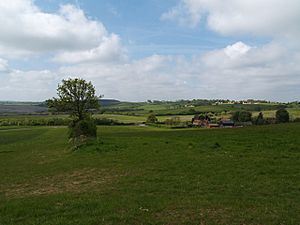Marston Vale facts for kids
Marston Vale is a special area in Bedfordshire, England. It is located southwest of Bedford and Kempston. This area was once famous for making bricks. Many years ago, large amounts of clay were dug from the ground here. This digging changed the landscape a lot.
Today, most of the old clay pits are empty. Many of the tall brick chimneys have been taken down. The area is now finding a new purpose. Some of the old clay pits have even been used as landfill sites. These sites are now closed and covered up.
Contents
The Forest of Marston Vale Project
The look and feel of Marston Vale are getting better. This is thanks to a big project called the Forest of Marston Vale. It is a community forest project. Its goal is to plant millions of trees. This helps to make the area green and beautiful again. It also creates new places for wildlife.
Villages in Marston Vale
Several villages are part of Marston Vale. These include Stewartby, Kempston Hardwick, Houghton Conquest, Marston Moretaine, Lidlington, Brogborough, Ridgmont and Wootton. A new town called Wixams also started being built here in 2007.
The village of Wootton Pillinge changed its name to Stewartby in 1937. This was to honor the Stewart family. They were very important in building the brick factories.
How Bricks Were Made Here
At its busiest time, Marston Vale had 162 tall chimneys for making bricks. In the 1970s, Bedfordshire made 20% of all the bricks in England. Before the factories closed, they made 135 million bricks each year.
The factories used a special type of clay called Oxford Clay. This clay was formed about 150 million years ago. Back then, the area was under the sea. The clay has about 5% seaweed in it. This natural material helped to burn the clay. It meant that less coal was needed to heat the kilns. Kilns are like giant ovens used to bake the bricks.
In February 2008, the main brick factory at Stewartby closed. This was because of new rules about air pollution. Even though the factory met European rules, it had trouble meeting stricter UK rules for sulphur emissions. In 2008, two old Hoffman kilns (CK1 and CK3) and four chimneys at the factory were given a special protection status. This means they are important historical buildings.
Getting Around Marston Vale
You can travel through Marston Vale by train. The local train line is called the Marston Vale Line. The main road that goes through the area is the A421.


